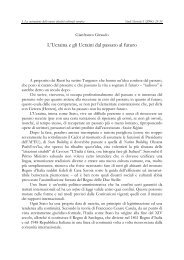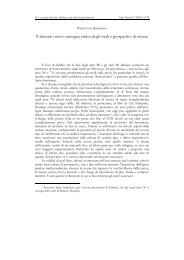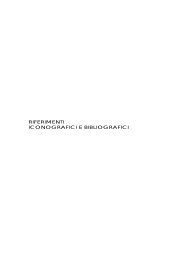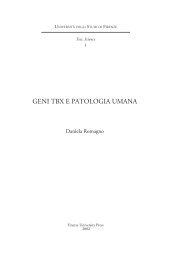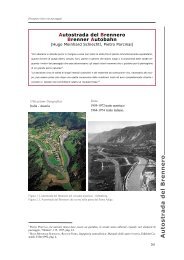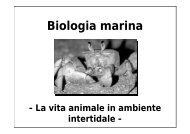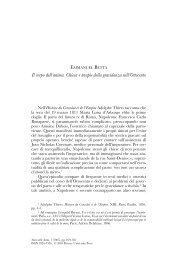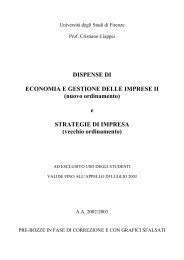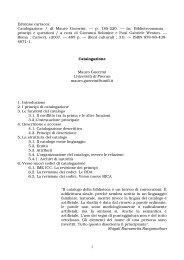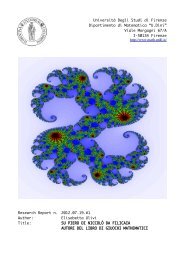200Strumenti della rete e processo formativoNorman D.A. (2000), Il computer invisibile - La tecnologia migliore è quella che non sivede, Milano, Apogeo (ed. orig. 1998)Norman D.A., Shallice T. (1980), Attention to action: Willed and automatic control ofbehaviour, in R. Davidson, G. E. Schwartz D. Shapiro, Consciousness and selfregulation, Plenun times, New York, pp. 1-18Novak J.D. (1990), Concept maps and Vee <strong>di</strong>agrams: Two metacognitive tools for scienceand mathematics education, in Instructional Science, 19, pp. 29-52Novak J.D. (2001), L’ appren<strong>di</strong>mento significativo. Le mappe concettuali per creare e usarela conoscenza, Erickson, TrentoNovak J.D. (s.d.), The Theory Underlying Concept Maps and How To Construct Them, inInternet all’in<strong>di</strong>rizzo: http://cmap.coginst.uwf.edu/info/O’ Neill K.D., Gomez L.M. (1994), The Collaboratory Notebook: a Networked Knowledge-Buil<strong>di</strong>ng. Environment for Project Learning, documento presentato all’Ed-Me<strong>di</strong>a, 1994,Vancouver (BC), in Internet http://www.covis.nwu.edu/info/papers/pdf/oneill-edme<strong>di</strong>a-94.pdfOliverio A. (1999), L’arte <strong>di</strong> imparare. A scuola e dopo, Rizzoli, MilanoOng W.J. (1986), Oralità e scrittura. Le tecnologie della parola, Il Mulino, Bologna (ed.orig. 1982)Ong W.J. (1989), Interfacce della parola, Il Mulino, Bologna (ed. orig. 1977)Orefice P. (1993), Didattica dell’ambiente, La Nuova Italia, <strong>Firenze</strong>Orefice P. (1997), Pour une théorie de la convergence en éducation des adultesInternational Council for Adult Education, in Convergence, vol. 2-3 pp. pp.138-149,Toronto, ICAE.Orefice P. (2001), I domini conoscitivi. Origine, natura e sviluppo dei saperi dell’homosapiens sapiens, Carocci, RomaOrefice P. (2003), La formazione <strong>di</strong> specie. Per la liberazione del potenziale <strong>di</strong> conoscenzadel sentire e del pensare, Guerini e Associati, MilanoOrr J. (1995), Con<strong>di</strong>videre le conoscenze, celebrare le identità. La memoria <strong>di</strong> una comunitàin una comunità <strong>di</strong> servizio, in C. Pontecorvo et al., I contesti sociali dell’appren<strong>di</strong>mento.Acquisire conoscenze a scuola, nel lavoro, nella vita quoti<strong>di</strong>ana, Ambrosiana, Milano pp.303-357 (ed. orig. 1990)Paavola S., Lipponen L., Hakkarainen K. (2002), Epistemological foundations for CSCL: Acomparison of three models of innovative knowledge communities, in Stahl G. (Ed.),Procee<strong>di</strong>ngs of CSCL 2002, Hillsdale, Lawrence Erlbaum, pp. 24-32, in Internethttp://newme<strong>di</strong>a.colorado.edu/cscl/228.htmlPaccagnella L. (2000), La comunicazione al computer, Bologna, Il Mulino.Palincsar A.S., Brown A.L. (1984), Reciprocal Teaching of Comprehension-MonitoringActivity, in Cognition and Instructions, 1, pp. 117-175Palloff R.M., Pratt K. (1999), Buil<strong>di</strong>ng learning communities in cyberspace: Effectivestrategies for the online classroom, Jossey-Bass, San Francisco CAPapert S. (1984), Mindstorms. Bambini, computer e creatività, Emme, Milano, ed. orig.Mindstorms. Computers, Children and Powerful Ideas, Basic Books, New York, 1980;Papert S. (1985), Situating Constructionism (Preface), in I. Harel, S. Papert (Eds.),Constructionism, Research reports and essays, pp. 1, Norwood, NJ, in Internet:
Strumenti della rete e processo formativo 201Papert S. (1994), I bambini e il computer, Rizzoli, Milano, ed. orig. The Children’s machine,HarperCollins, New York, 1992Parisi D. (1993), Tecnologie della mente corpo, in P. L. Capucci (a cura <strong>di</strong>), Il corpotecnologico, Milano, Baskerville, 1993, pp. 131-142.Parisi D. (2000), La scuol@.it, Mondadori, MilanoParks, M.R., Floyd, K. (1996), Making friends in cyberspace, in Journal of Communication,46(1), p. 80-97 (Pubblicato anche online nel Journal of Computer-Me<strong>di</strong>atedCommunication)Pea R. (1993), Practices of <strong>di</strong>stributed intelligence and designs for education, in Salomon,Distributed cognitions. Psychological and educational considerations, CambridgeUniversity Press, Cambridge MAPellerey M. (1994), La razionalità umana: <strong>di</strong>mensioni e con<strong>di</strong>zioni <strong>di</strong> sviluppo, in B.Vertecchi (a cura <strong>di</strong>), Formazione e curricolo, La Nuova Italia, <strong>Firenze</strong>, pp. 47-67.Pennington M.C. (1996), The Computer and the Non-Native Writer: A Natural Partnership,Hampton Press, Cresskill, New JerseyPenrose R. (1992), La mente nuova dell’imperatore, Milano, Rizzoli (ed. orig. 1989)Perkins D.N. (1986), Thinking frames: a model for teaching thinking, in Baron J., SternbergR. (ed.), Teaching thinking skills: Theory and practice, Freeman, New York, pp. 285-304Perkins D.N. (1993), Person-plus: a <strong>di</strong>stributed view of thinking and learning, in SalomonG. (ed.), Distributed cognitions. Psychological and educational considerations,Cambridge University Press, Cambridge MA, pp. 88-110Perriault J. (1989), La logique de l’usage. Essai sur les machines à communiquer,Flammarion, ParisPerriault J. (2002), Education et nouvelles technologies. Théorie et pratiques, NathanUniversité, Saint-Germain-du-PuyPersico D., Bell C., Thomson A., Midoro V., Tornatore L. (1993), Dibattito in due battutesulle tecnologie <strong>di</strong>dattiche, in TD, E<strong>di</strong>zioni Menabò, Ortona, n. 1, pp. 5.Person N.K., Graesser A.C., Kreuz R.J., Pomeroy V., Tutoring Research Group (2001),Simulating human tutor <strong>di</strong>alogue moves in AutoTutor, in International Journal ofArtificial Intelligence in Education, 12(2001), pp. 23-39Pessa E., Penna M.P. (2000), Manuale <strong>di</strong> scienza cognitiva. Intelligenza artificiale classica epsicologia cognitiva, Laterza, Roma-BariPiaget J. (1973), La costruzione del reale nel bambino, La Nuova Italia, <strong>Firenze</strong> (ed. orig.1937)Pontecorvo C. (1993), Interazione sociale e conoscenza. Le <strong>di</strong>scipline come pratiche <strong>di</strong><strong>di</strong>scorso, in Scuola e città, n.2, febbraio 1993, pp.56-70Pontecorvo C., Ajello A.M., Zucchermaglio C. (a cura <strong>di</strong>) (1995), I contesti socialidell’appren<strong>di</strong>mento. Acquisire conoscenze a scuola, nel lavoro, nella vita quoti<strong>di</strong>ana,Ambrosiana, MilanoPontecorvo C., Ajello A.M., Zucchermaglio C. (a cura <strong>di</strong>) (2004), Discutendo si impara.Interazione sociale e conoscenza a scuola, Carocci, RomaPostman N. (1983), Ecologia dei me<strong>di</strong>a. L’insegnamento come attività conservatrice,Armando, Roma (ed. orig. 1979)
- Page 1 and 2:
TESIUMANISTICA- 3 -
- Page 3 and 4:
Giovanni BonaiutiStrumenti della re
- Page 5 and 6:
Strumenti della rete e processo for
- Page 7 and 8:
Strumenti della rete e processo for
- Page 9 and 10:
Strumenti della rete e processo for
- Page 11 and 12:
Teorie, modelli e artefatti per la
- Page 13 and 14:
Teorie, modelli e artefatti per la
- Page 15 and 16:
Teorie, modelli e artefatti per la
- Page 17 and 18:
Teorie, modelli e artefatti per la
- Page 19 and 20:
Teorie, modelli e artefatti per la
- Page 21 and 22:
Teorie, modelli e artefatti per la
- Page 23 and 24:
Teorie, modelli e artefatti per la
- Page 25 and 26:
Teorie, modelli e artefatti per la
- Page 27 and 28:
Teorie, modelli e artefatti per la
- Page 29 and 30:
Teorie, modelli e artefatti per la
- Page 31 and 32:
Teorie, modelli e artefatti per la
- Page 34 and 35:
32Strumenti della rete e processo f
- Page 36 and 37:
34Strumenti della rete e processo f
- Page 39 and 40:
Teorie, modelli e artefatti per la
- Page 41 and 42:
Teorie, modelli e artefatti per la
- Page 43 and 44:
Teorie, modelli e artefatti per la
- Page 45 and 46:
Teorie, modelli e artefatti per la
- Page 47 and 48:
Teorie, modelli e artefatti per la
- Page 49 and 50:
Teorie, modelli e artefatti per la
- Page 51 and 52:
Teorie, modelli e artefatti per la
- Page 53 and 54:
Teorie, modelli e artefatti per la
- Page 55 and 56:
Teorie, modelli e artefatti per la
- Page 57 and 58:
Teorie, modelli e artefatti per la
- Page 59 and 60:
Teorie, modelli e artefatti per la
- Page 61 and 62:
Strumenti e ambienti per la formazi
- Page 63 and 64:
Strumenti e ambienti per la formazi
- Page 65 and 66:
Strumenti e ambienti per la formazi
- Page 67 and 68:
Strumenti e ambienti per la formazi
- Page 69 and 70:
Strumenti e ambienti per la formazi
- Page 71 and 72:
Strumenti e ambienti per la formazi
- Page 73 and 74:
Strumenti e ambienti per la formazi
- Page 75 and 76:
Strumenti e ambienti per la formazi
- Page 77 and 78:
Strumenti e ambienti per la formazi
- Page 79 and 80:
Strumenti e ambienti per la formazi
- Page 81 and 82:
Strumenti e ambienti per la formazi
- Page 83 and 84:
Strumenti e ambienti per la formazi
- Page 85 and 86:
Strumenti e ambienti per la formazi
- Page 87 and 88:
Strumenti e ambienti per la formazi
- Page 89 and 90:
Strumenti e ambienti per la formazi
- Page 91 and 92:
Strumenti e ambienti per la formazi
- Page 93 and 94:
Strumenti e ambienti per la formazi
- Page 95 and 96:
Strumenti e ambienti per la formazi
- Page 97 and 98:
Strumenti e ambienti per la formazi
- Page 99 and 100:
Strumenti e ambienti per la formazi
- Page 101 and 102:
Strumenti e ambienti per la formazi
- Page 103 and 104:
Strumenti e ambienti per la formazi
- Page 105 and 106:
Strumenti e ambienti per la formazi
- Page 107 and 108:
Strumenti e ambienti per la formazi
- Page 109 and 110:
Strumenti e ambienti per la formazi
- Page 111 and 112:
Strumenti e ambienti per la formazi
- Page 113 and 114:
Strumenti e ambienti per la formazi
- Page 115 and 116:
Strumenti e ambienti per la formazi
- Page 117 and 118:
Strumenti e ambienti per la formazi
- Page 119 and 120:
Strumenti e ambienti per la formazi
- Page 121 and 122:
Strumenti e ambienti per la formazi
- Page 123 and 124:
Strumenti e ambienti per la formazi
- Page 125 and 126:
Strumenti e ambienti per la formazi
- Page 127 and 128:
Strumenti e ambienti per la formazi
- Page 129 and 130:
L’indagine empirica e le verifich
- Page 131 and 132:
L’indagine empirica e le verifich
- Page 133 and 134:
L’indagine empirica e le verifich
- Page 135 and 136:
L’indagine empirica e le verifich
- Page 137 and 138:
L’indagine empirica e le verifich
- Page 139 and 140:
L’indagine empirica e le verifich
- Page 141 and 142:
L’indagine empirica e le verifich
- Page 143 and 144:
L’indagine empirica e le verifich
- Page 145 and 146:
L’indagine empirica e le verifich
- Page 147 and 148:
L’indagine empirica e le verifich
- Page 149 and 150:
L’indagine empirica e le verifich
- Page 151 and 152: L’indagine empirica e le verifich
- Page 153 and 154: L’indagine empirica e le verifich
- Page 155 and 156: L’indagine empirica e le verifich
- Page 157 and 158: L’indagine empirica e le verifich
- Page 159 and 160: L’indagine empirica e le verifich
- Page 161 and 162: L’indagine empirica e le verifich
- Page 163 and 164: L’indagine empirica e le verifich
- Page 165 and 166: L’indagine empirica e le verifich
- Page 167 and 168: L’indagine empirica e le verifich
- Page 169 and 170: L’indagine empirica e le verifich
- Page 171 and 172: L’indagine empirica e le verifich
- Page 173 and 174: L’indagine empirica e le verifich
- Page 175 and 176: L’indagine empirica e le verifich
- Page 177 and 178: Strumenti della rete e processo for
- Page 179 and 180: Strumenti della rete e processo for
- Page 181 and 182: Strumenti della rete e processo for
- Page 183 and 184: Strumenti della rete e processo for
- Page 185 and 186: Strumenti della rete e processo for
- Page 187 and 188: Strumenti della rete e processo for
- Page 189 and 190: Strumenti della rete e processo for
- Page 191 and 192: Strumenti della rete e processo for
- Page 193 and 194: Strumenti della rete e processo for
- Page 195 and 196: Strumenti della rete e processo for
- Page 197 and 198: Strumenti della rete e processo for
- Page 199 and 200: Strumenti della rete e processo for
- Page 201: Strumenti della rete e processo for
- Page 205 and 206: Strumenti della rete e processo for
- Page 207 and 208: Strumenti della rete e processo for
- Page 209: RingraziamentiRingrazio nella perso



